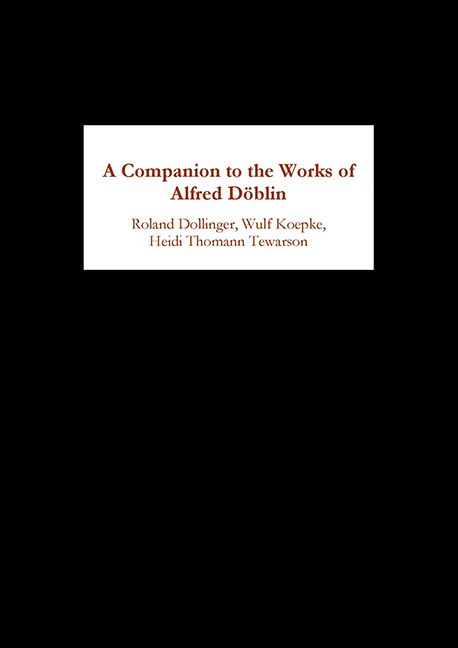Book contents
- Frontmatter
- Contents
- Foreword
- Abbreviations and Translations of Titles
- Works by Alfred Döblin
- Introduction
- Early Works
- Works of the Weimar Period
- The Fall of Wallenstein, or the Collapse of Narration? The Paradox of Epic Intensity in Döblin's Wallenstein
- Technology and Nature: From Döblin's Berge Meere und Giganten to a Philosophy of Nature
- “Arzt und Dichter”: Döblin's Medical, Psychiatric, and Psychoanalytical Work
- Döblin's Berlin: The Story of Franz Biberkopf
- Döblin's Engagement with the New Media: Film, Radio and Photography
- Döblin's Political Writings during the Weimar Republic
- Exile and Return to Europe
- Bibliography
- Notes on the Contributors
- Index
Döblin's Engagement with the New Media: Film, Radio and Photography
from Works of the Weimar Period
Published online by Cambridge University Press: 27 April 2017
- Frontmatter
- Contents
- Foreword
- Abbreviations and Translations of Titles
- Works by Alfred Döblin
- Introduction
- Early Works
- Works of the Weimar Period
- The Fall of Wallenstein, or the Collapse of Narration? The Paradox of Epic Intensity in Döblin's Wallenstein
- Technology and Nature: From Döblin's Berge Meere und Giganten to a Philosophy of Nature
- “Arzt und Dichter”: Döblin's Medical, Psychiatric, and Psychoanalytical Work
- Döblin's Berlin: The Story of Franz Biberkopf
- Döblin's Engagement with the New Media: Film, Radio and Photography
- Döblin's Political Writings during the Weimar Republic
- Exile and Return to Europe
- Bibliography
- Notes on the Contributors
- Index
Summary
Early Encounters with Film
Döblin was an inquisitive author, who strolled through Berlin, the center of his life, with open eyes and ears, as one for whom everything became fit material for his writing. Innovations and especially all things technical fascinated him: “eine surrende Dynamomaschine in einem Keller, an dem ich vorbeigehe, wühlt mich auf; ich gehe beschenkt ‘wie im Traum,’ es ist ein Anruf, meine Kraft ist wieder da” (SLW, 39). Not surprisingly, the technological innovation of Lumière's cinematograph caught his attention. Döblin was one of the first to visit the cinemas then opening in Berlin, and promptly wrote about the “Theater der kleinen Leute” (Theater of the Little People, 1909) (KS-1, 71–73). However, his interest was aroused less by the new medium of moving pictures and more by the locales in which they were shown, the “Kientopps,” as they were colloquially called in Berlin.
Döblin was captivated by the audience and the atmosphere, where “ein Monstrum von Publikum, [. . .] eine Masse, [. . .] dieses weiße Auge mit seinem stieren Blick zusammenbannt” (KS-1, 72). He remarked on the audience's primal needs, its simple greedy voyeurism, its desire to be “gerührt, erregt, entsetzt [. . .]; mit Gelächter losplatzen” (KS-1, 71). “Kientopp” did not aspire to art and its lofty experience, but catered to the “schaurige Lust am Schauen von Greuel, Kampf und Tod.” Film in its early years was characterized by its appeal to bare emotions, above all the “höchst Verwunderlichen und durchaus Gräßlichen” (KS-1, 71). Indeed, the first films were shown in amusement parks, panoptica, varietés, and flea markets. In time, cinemas were established in various other places, such as “in verräucherten Stuben, Ställen, unbrauchbaren Läden,” and finally in “großen Sälen, weiten Theatern” (KS-1, 71).
Unlike the theater, with its regular performance time, cinemas served an audience that liked to take advantage of the continuous showings, depending on the occasion, time available, or the schedule of the day. This fact of not being bound to a certain time constituted the market value of the new medium and also became symptomatic for the changing attitude of urban modernity. The conditions varied considerably, however, from country to country. In Germany, the movie theaters were rather modest places and offered continuous showings.
- Type
- Chapter
- Information
- A Companion to the Works of Alfred Döblin , pp. 161 - 182Publisher: Boydell & BrewerPrint publication year: 2003



